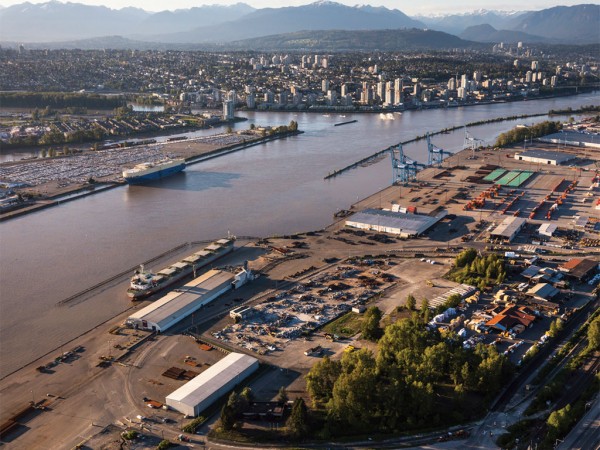Jan-Ludwig Beringer, CEO of Rohde & Liesenfeld Canada Inc., says Canada’s west coast ports aren’t up to the task of handling project cargos.
A veteran project forwarder based in Calgary, in the heart of western Canada’s energy industry that in the past year has been crippled by the severe downturn in world oil markets, Jan-Ludwig Beringer is well known among his peers for his sense of humour – but also for not mincing words when assessing difficult situations. This was borne out in a recent interview combined with emailed comments.

In recent years, he said, railways and terminal operators have notably invested large sums for handling bulk commodities in west coast ports. For breakbulk cargo, Beringer qualifies things as “a disaster.”
“Major projects like LNG terminals, propane terminals, petrochemical plants, polyethylene plants or Wind Energy parks being planned or being built in British Columbia, Alberta and Saskatchewan, are all negatively impacted by inadequate, costly and unpredictable project cargo break-bulk handling capabilities in Canada’s west coast ports.”
The six deep-water project break-bulk terminals on the west coast, Fraser Surrey Docks, Lynnterm (in Port of Vancouver), Squamish, Prince Rupert and Stewart World Port, ranging in geographical locations from the mouth of the Fraser river to the BC Pacific border with Alaska, all lack proper break-bulk handling capabilities and capacity, according to Beringer.
Seven Main Issues
In comparison to North America’s leading project break-bulk port of Houston, Texas these six Canadian entities are all at a distinct disadvantage. Beringer lists the seven main issues as follows:
“First, there are no shore cranes to handle break-bulk project cargos, meaning vessel’s gear is the only cost effective way to discharge project cargos. Once the cargo is on the terminal, there is no way to effectively reload it again onto a conveyance for further inland movement.
“Secondly, no right to work legislation is in place to create competition – meaning all labor has to come from the Longshoreman’s union halls at union rates.
“Thirdly, private trades, specialized riggers, trained heavy-haul drivers, jacking crews, crating and inspections/survey personnel have limited or no access to perform any work on these port terminal facilities without shadowing labor with an equal number of union workers and hours.
“Fourthly, terminal handling costs cannot be fixed or budgeted for a project and there is no such thing as a project specific terminal handling rate. Unionized gang hour rates and shadow labor rates for trades brought in to work under union labor agreements is the customary way terminal handling costs are assessed to the cargo owners. These costs can easily run into a six figure amount for each project cargo discharged at a western Canada port. Terminal handling costs are sometimes higher than the ocean freight cost that was paid to get the project cargos from the overseas port of loading to the Canadian port of discharge.
“Fifthly, terminal space is extremely limited and there is little opportunity to effectively manage the movement of project cargos off of the ports, as the loading of cargos is limited to available union gang hours and handling equipment.
“Sixthly, no SPMT trailers, maffey trailers, tractor units or heavy-duty trailers of any kind are available for ground handling or interim storage of project cargos after vessel’s discharge.

“And lastly, experienced union trades to perform cost effective rail car loading, tie-down and securing to AAR requirements are not readily available. A lot of project cargos, particularly pipe, are transloaded off the terminals using trucks to off-dock rail car sidings for loading into rail cars. This double handling is prohibitively expensive and could easily be avoided if rail car loading could be performed cost effectively on the port terminal property.”
Challenges for Project Owners
With all these project cargo handling limitations, how do project owners plan and budget for the movement of all their capital equipment from off-shore manufacturing locations to final destination in the three main project destinations: BC, Alberta and Saskatchewan? The answer is that they find it very challenging compared to other areas in the world, affirms Beringer.
“Project owners burn through huge upfront logistics hours with EPC’s, Freight Forwarders, Asset Based Heavy-haul companies and Consultants to try and a) understand the cost components that make western Canadian ports so expensive, and limited in their capabilities, and b) in finding any possible work-around solutions.”
The Houston Factor
Are there some current work-around solutions? Here, Beringer is skeptical. “There are none that are cost effective and would ever bring costs down to the level of Houston. Western Canadian ports are quite simply put, both expensive in handling heavy-lift and out of gauge project cargos and difficult to circumvent, outside of bringing project cargos in from the Gulf on the well established high-wide road corridor up to western Canada destinations. Something that currently does not exist on any highway routes from the Great Lakes ports of Thunder Bay or Duluth and certainly not from any B.C. ports of entry. B.C. and the Southern border state of Washington with entry ports like Seattle, Tacoma, Vancouver, Everett and other smaller ports in Washington state, also do not have any established high wide corridors for project cargos.”
“Routes from any of these ports,” continued Beringer, “require extensive bridge surveys and route surveys to be completed and individual permits applied for on each heavy-lift or over-dimensional cargo moving through those jurisdictions. Evidence of a previous move of similar weight or size does not waive the requirement for going through the whole bridge engineering and road survey process again for a new permit.”
In conclusion, Beringer said: “Overall, there needs to be an initiative to improve the break-bulk project cargo handling capabilities in Western Canada’s deep water sea ports if we want to encourage project owners to invest in building major projects in western Canada. The current environment of foreign funded protest groups operating against new developments in the fossil fuel energy sector, the high costs and uncertainty of new planned construction projects due to excessive government permitting and environmental impact studies, and on top of all of that, the high costs and constraints of delivering break-bulk project cargos through to construction sites, places Western Canada into a distinctive disadvantage over U.S. competitors, particularly in the Gulf states. Government, private industry and the waterfront unions need to work together to improve our ports in order to compete with our southern neighbors in attracting new project investments.”





